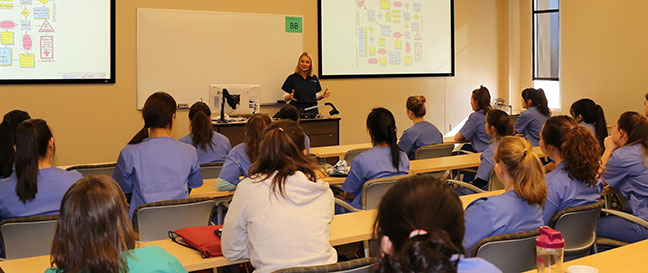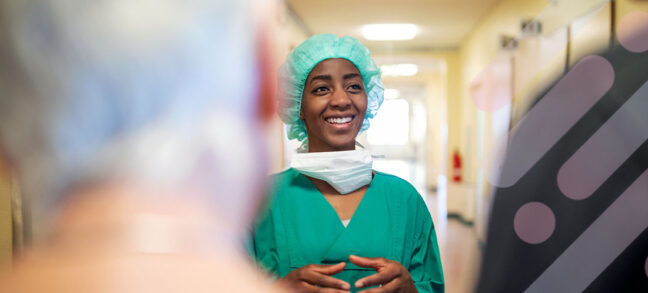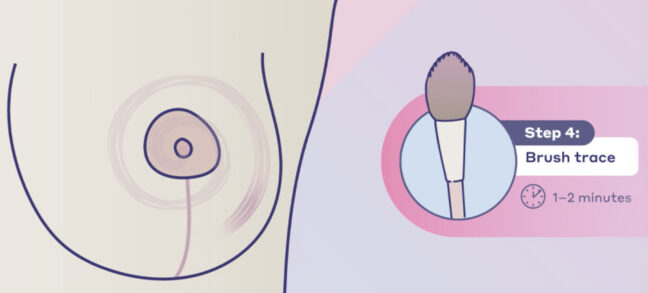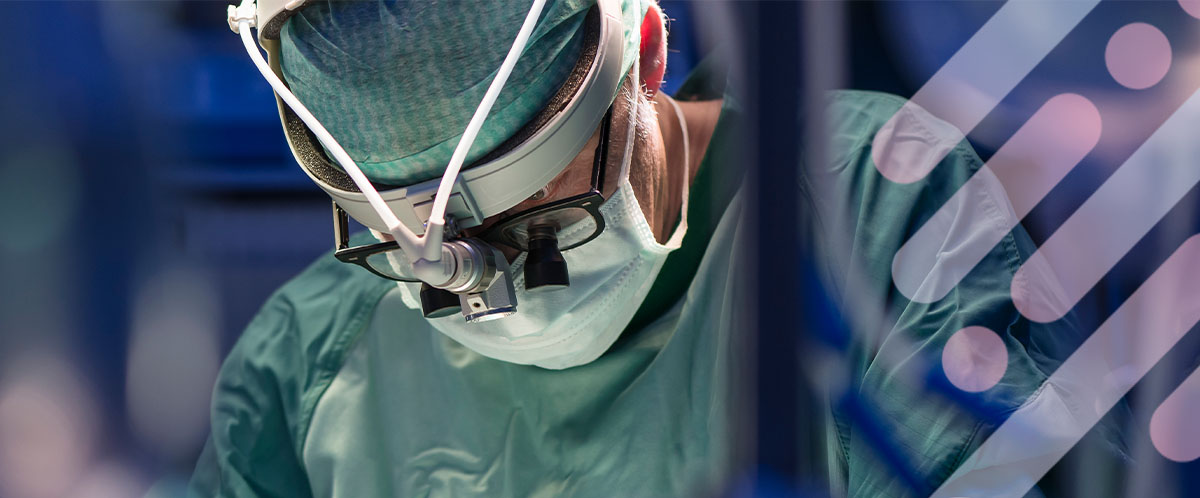Axogen Corporation
An Interview with Axogen® Chairman, CEO, and President Karen Zaderej
Undergoing a mastectomy can present a life-saving opportunity for women faced with breast cancer. Yet mastectomies come with long-term side effects, including persistent numbness in the area where the breast tissue was removed.
The reason for this loss of sensation: During a mastectomy, nerves that provide sensation to the breast are cut when the breast tissue is removed, creating a loss of sensation. This numbness can persist even after breast reconstruction surgery.
Although autologous breast reconstruction (breast reconstruction using your own tissue) is focused on restoring the shape, symmetry and size of the breast, the possibility of restoring sensation by repairing the nerves in the new breast is not typically offered as an option for the vast majority of women.
“We often talk about the four S’s of breast reconstruction: size, shape, softness and symmetry,” said Axogen Chairman, CEO and President Karen Zaderej. “We think there should be a fifth– sensation.”
But the days of women having to simply accept that their reconstructed breasts would be unable to sense warmth, cold, or touch are numbered. Axogen (AXGN), a leader in peripheral nerve regeneration and repair, is offering a solution that potentially enables plastic surgeons to restore sensation to the reconstructed breasts of women after mastectomies.
Breast neurotization with Resensation reconnects nerves that were severed during mastectomy to those in the newly formed breast. Resensation helps women not just look – but potentially feel – more like themselves again.
Zaderej shares what inspired her team to pursue breast reconstruction neurotization for women who are undergoing breast reconstruction after mastectomy, the potential impact of Resensation on quality of life, and the possibility for breast neurotization to change what women should expect after autologous breast reconstruction.
How did you come to recognize that loss of sensation after mastectomy is a problem for women and that Axogen should focus on developing a solution?
Axogen has been solving problems in peripheral nerves for more than 15 years. We have lots of data on sensory nerves from our work repairing nerves in the hands, feet, legs, tongue, and jaw. Sensory nerves throughout the body follow the same mechanisms of healing, so our data is directly applicable to breast nerve restoration.
I have family members and friends who had breast surgery. I have to admit, I was surprised to find out that they didn’t get sensory return. After the cancer was removed and breast reconstruction completed, they were disappointed to discover that they couldn’t feel their breasts.
Being diagnosed with breast cancer is a traumatic and emotional event. You have to make a lot of difficult decisions about treatment, whether to do reconstruction, and what type of reconstruction to choose. Women go through all that trauma and they get to the end and they look fine, but they may have little to no sensation in their breast.

What do women tell you is bothersome about numbness in their breasts?
Breast sensation is about feeling normal again. Women tell us that if you can’t feel the tissue, it doesn’t feel like yours. It feels alien to you. Women have an emotional attachment to their breasts. It has to do with body image, but it’s more than that. It also has to do with feeling feminine and intimacy.
Every woman’s experience with breast cancer and mastectomy is unique. When women decide to have a mastectomy to remove cancer or prevent cancer, their focus is on life. Many times, women who prophylactically have a mastectomy do it because they had a family member who died. They’re doing it because they want to live. For women with breast cancer, after they’ve gone through a mastectomy, they often feel grateful to be alive.
But at some point, many women start thinking about reconstruction. They go through that process and they look fine, but they can’t feel their breast. Some women say they feel like they’re not symmetrical. They look normal, but they don’t feel normal.
Why do you think the loss of sensation in the breast after mastectomy hasn’t gotten that much attention until now?
Sensation is not something we talk about enough. Breasts are an intimate part of the body. Women have been hesitant to talk about it too much, or to talk about it in a public setting. It’s hard to talk about breast surgery without pointing to your breasts or calling attention to them, and this isn’t something a lot of women are comfortable with. I want to make this a comfortable and acceptable conversation for women to share and not be embarrassed. I also think there is a little bit of guilt for some women too. They feel they should be grateful that they no longer have cancer.
I want women to feel they have the right to choose whether reconstruction is the right option for their life, and to have the possibility to potentially return to feeling normal.
A lot of women never tell their surgeon that they are unhappy with the loss of sensation. Some surgeons aren’t aware that the loss of feeling is a significant issue for their patients and they are not aware that breast nerve restoration is a possibility. So, the loss of sensation is something that women talk about only in the privacy of their own home, or with friends and family.
How was Resensation developed?
For every challenge, there are always medical pioneers who recognize a patient problem and work tirelessly to solve it. Breast sensation following breast reconstruction is no different. Axogen worked with a group of leading experts in breast reconstruction -– pioneering surgeons who believed there was a real opportunity to make a fundamental shift in what a woman should potentially expect when she has breast reconstruction surgery. We combined their surgical expertise with our deep knowledge of nerves and nerve regeneration to develop the Resensation technique.
Reconstruction has traditionally focused on appearance. How does the Axogen procedure change that paradigm?
Breast reconstruction has come a long way. The outcomes, in terms of how breasts look, are very reliable. In many women, it’s hard to tell they had surgery at all. It’s hard to see the scars. Surgeons do a beautiful job giving women the look and shape of a breast.
But the whole concept of sensation has been downplayed. Breast reconstruction up until now has been more about aesthetics, which is outward-focused and involves the way other people see you. Resensation is inward focused. It is about the woman. This is a major shift that will allow women to have the outcomes they desire. We believe that regaining sensation is going to have a major impact on a woman’s quality of life.
How much sensation is returned?
We’re working with several major universities to gather that data. We currently have over 1,400 nerve repair procedures enrolled in our RANGER® registry to measure outcomes for a wide variety of applications for peripheral nerve repair. In addition, other published data that utilizes our allograft nerve tissue for supporting return of sensation tells us we can get meaningful outcomes in 86% to 92% of the nerves that are repaired.1,2
Sensation-NOW™ (Neurotization Outcomes for Women) is an arm of the RANGER registry focused on measuring outcomes for breast neurotization specifically. We will measure the psychological impact, physical impact, and quality of life impact of breast neurotization. After mastectomy, women can also be at risk of pain in the area where the nerves were damaged. We are also evaluating if breast nerve repair can help with this pain.
The academic centers are very supportive about gathering this information and building a repository of data that aims to change the standard of care. That’s how you change medicine, you provide surgeons with good evidence to help them make better decisions. I think Sensation-NOW will do that.
If a woman is interested in the possibility of restoring sensation, what questions should she ask her surgeons?
A woman has a lot of choices to make from the time she is diagnosed with breast cancer and plans to have a mastectomy, or from the time she decides to prophylactically have a mastectomy. She needs to decide who’s going to be the breast surgeon to manage the removal of the tissue. Then she needs to decide if she is going to have a reconstruction, what type of reconstruction, whether she wants an immediate or delayed reconstruction and who will be her plastic surgeon to do the reconstruction.
Reconstruction surgery with Resensation can be done right after a mastectomy or after some time has passed. Resensation technique uses allograft nerve tissue to reconnect and bridge the gap between the nerves in your chest and the nerves in your reconstructed breast tissue. Over time, the nerve fibers regenerate across the allograft, then continue to grow to the skin.
If a woman is interested in exploring the possibility of restoring sensation, she needs to look for surgeons who are performing the Resensation procedure. She needs to let her surgeon know that breast neurotization and a return of sensation is important to her.
What makes you most proud about the work the team at Axogen is doing?
I am enormously proud of the team at Axogen. They wake up every day and think about what they can do to make patients’ lives better. And they stay unwaveringly committed to
that. It’s hard work, but they do it in partnership with wonderful pioneering surgeons who are equally passionate about it and I think each group feeds off the other to make new options in care possible. We all see the potential to dramatically change breast reconstruction surgery, and that carries us through the effort.
Should all women seek Resensation after mastectomy?
It’s a very personal choice. Some women don’t want reconstruction. They might wear a prosthetic or they might just go without breasts. That’s what’s right for them. Some women will want to go through reconstruction and have the potential to have sensation restored. I think each woman makes the best choice for her life, to give her the greatest happiness and outcomes.
_________________________
- Zuniga JR, Williams F, Petrisor D. A Case Control, Multi-Site, Positive Controlled, Prospective Study of the Safety and Effectiveness of Immediate Inferior Alveolar Nerve Processed Nerve Allograft Reconstruction with Ablation of the Mandible for Benign Pathology. J Oral Maxillofac Surg. 2017 Apr; E-pub ahead of print. Doi:10.1016/joms.2017.04.002
- Rinker BD, Zoldos J, Weber RV, et al. Use of Processed Nerve Allografts to Repair Nerve Injuries Greater than 25mm in the Hand. Ann Plast.Surg. 2017 Jun;78(6S Suppl 5):S292-S295. doi: 0.1097/SAP.0000000000001037.
Resensation Articles

How does mastectomy impact the nerves in the breast?
One sometimes overlooked aspect of mastectomy is its impact on nerves. Read what happens to nerves during mastectomy and explore…
Read More
What happens during implant breast reconstruction with Resensation®?
By repairing sensory nerves, Resensation® enables you to potentially regain sensation to your chest. Read how this procedure works during…
Read More
how resensation® helped Leanna feel secure in her family’s future
With Resensation®, Leanna can be there to watch her kids grow up—without losing the feeling of being whole.
Read More
post-surgery sensory retraining: instructions and video guide
Sensory retraining is a series of exercises designed to help you reconnect with your body after breast reconstruction with Resensation®.
Read More